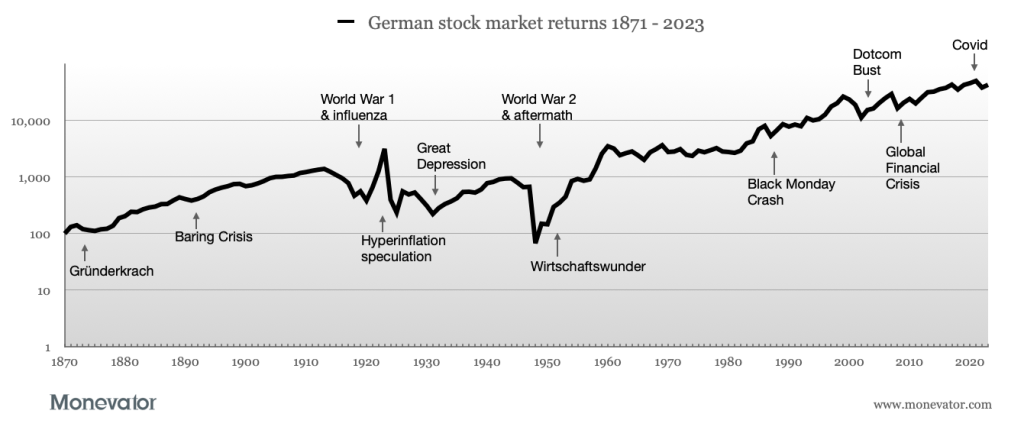
Rules are made to be broken, they say. So is it ever acceptable for a passive investor to stop slumbering like a panda on Temazepam, turn the portrait of St. John Bogle to face the wall, and break their own investing vows in response to market crazy? To try to – gasp – time the market?
If so, when?
The question was prompted by Monevator reader, Adam, in the aftermath of the 2022 bond market bloodshed.
Adam queried whether a passive investor should:
…write this chapter off as a one-off anomaly and stick to their mechanical rebalancing guns that have generally worked over the long run? Or take it as evidence that a tactical deviation from their long-term strategic asset allocation can be merited under certain circumstances and incorporate that into their investment approach going forward?
Sacrilege!
Adam’s thesis is there are episodes when the market looks so distorted that it’s probably better to take action rather than stick to a holy writ that says: “Thou shalt not change thy asset allocation excepting to rebalance on the Sixth Sunday after Bondogeddon.”
Perhaps I should be calling in the Passive Investing Inquisition to deal with Adam’s blasphemy?
Not this time.
The truth is I wholeheartedly agree with his premise. I suspect you do, too. And we don’t have to look hard for passive investing luminaries to back us up.
But how do you tell when the moment has come for legit evasive manoeuvres – as opposed to the standard knee-jerk fiddling that just amounts to ill-advised market timing?
I think the trigger for positive action is when we’re approaching a market extreme.
The mental image that illustrates such a moment for me is the Death Star moving into firing position against the Rebels in Star Wars.
The battle station slowly rounds the intervening gas giant that stands between the good guys and planet-killing laser death.
The Death Star approaches. At this point, it’s okay to do something. Awooga! Awooga! All hands!
The Rebels can see it coming. If they don’t do something, they’re finished.
Time to dispatch the X-wings.
Let go of your hate
The market Death Star bearing down on bonds was built from:
More than a decade of near-zero interest rates
A global economy bottlenecked by Covid lockdowns and reopenings
The biggest US fiscal stimulus of all-time jump-starting inflation
It’s all easier with hindsight, right?
I certainly didn’t know bonds were going to get blasted as badly as they were. But the battlefield was clearly heavily tilted against them. Especially the longer maturities.
My response wasn’t to dump my own bonds wholesale. But I did advocate a series of cagey moves designed to partially raise the deflector shields against a moon-sized threat.
There was definitely a case for paring back a large allocation to conventional bonds and redeploying some of its defensive duties to other diversifiers.
Cash, index-linked bonds, and gold.
I’m not claiming prescience. I also took plenty of damage from 2022’s historic gilt shoeing.
My point is to illustrate that the balance of risks was stacked against business-as-usual. That justified some shift in strategic asset allocation.
Bubble bubble, toil and trouble
The more common extreme that potentially warrants off-piste action is a stock market bubble.
Let’s time travel back to the early 1990s. Passive investing was only in its infancy then – when the Japanese asset bubble burst.
Speculation had been rampant in the run up to the crash. Matrix-like glitches in reality included:
The land value of Tokyo’s Imperial Palace was supposedly higher than all of CaliforniaJapanese shares were worth more than the entire US stock marketJapan’s stock market CAPE ratio headed north of 70. (That’s big, CAPE fans!)
Inflation-adjusted returns. Dividends included. Data source: Russell/Nomura Japan Index. Inflation: CPI.
History tells us that markets rising on super-heated thermals can only defy gravity for so long.
But while the bubble inflates, it’s as if Einstein’s laws are suspended. The dumb money looks smart as it’s suckered into a black hole of delusion.
In Japan’s case the resulting implosion irradiated the next 20 years for investors in that market.
Or, for a more up to date example, think of how (not so) well the Crypto-space did in 2022, following the Peak Madness of 2021.
Alternatives to trying to time the market
The problem is that the event horizon where the market pops is never visible in advance.
Moreover, passive investors are generally urged to avoid second-guessing the market in order to protect themselves against taking misguided actions.
So what can you do when the market seemingly goes Looney Tunes?
There are two techniques to turn to: threshold rebalancing and overbalancing.
Both introduce automatic breakpoints that help you de-risk during a fast-moving market.
Overbalancing is the lesser-known technique. It’s often recommended by one of the great champions of passive investing, William Berstein.
Here’s Bernstein’s explanation:
If the stock market goes up X%, you want to decrease your asset allocation by Y%.
What’s the ratio between X and Y?
If the market goes up 50%, maybe I want to reduce my stock allocation by 4%. So there’s a 12.5 ratio between those two numbers.
Well, that’s what it really all boils down to: What’s your ratio between those two numbers?
Bernstein is indifferent as to whether your allocation changes by 2%, 4% or 5% in response to the big market shift.
Point being: do not fixate on the number. This is not a science and there’s no magic formula.
Overbalancing like this works because it causes you to slowly vent the risk building in your portfolio as market pressure mounts.
How do you spot a market bubble?
Bernstein has developed a bubble-spotting heuristic – one which only requires that you pay attention to the media and the people around you.
He relates his four danger signals in an interview with The White Coat Investor:
Number one is when something becomes a topic of everyday conversation. When you go to a party or a social engagement and people are talking about how wealthy they are getting trading bitcoin or tech stocks or real estate, that’s a sign that you’re in a bubble.
The second sign that you’re in a bubble is when people quit perfectly good professions to day trade or to trade mortgages or securities. We saw that of course during the late ’90s when medical doctors and lawyers quit what they were doing to day trade.
Number three is when you express skepticism about a particular investment and you get really angry responses. When skepticism has met with vehemence, that’s a third sign.
Then finally, number four is when you start seeing extreme price predictions. So when people say that the price of something’s not just going to go up or down by 20%, which is the typical sort of prediction you have for the stock market, but the prices are going to quadruple or fall by a factor of four.
Remembering Bernstein’s advice kept me out of crypto when the block chain / defi / Web 3.0 hype made me feel like the biggest fool west of Babylon.
It looked insane to pile into crypto in 2021. Turned out it was insane.
But the madness of crowds is infectious. And it’s hard to tell who’s irrational when you’re living in the asylum.
Guiding light
I think of passive investing as a system of useful heuristics that guide me through hostile investing terrain.
After all, the financial markets are a capricious environment that can take down even seemingly brilliant navigators.
But while good guidelines keep you heading in the right direction, they can’t tell you how to negotiate every situation.
No rulebook contains all the rules.
That doesn’t mean passive investing is broken or as outmoded as the biblical injunction to not “mar the edges of your beard.”
We should always be prepared to adapt our principles. But not to abandon them.
In the case of passive investing in an uncertain world, I believe that means following the rules most of the time… but also keeping your eyes open for major market changes that merit a cautious countermove in response.
If we see one, we’ll let you know.
Take it steady,
The Accumulator
The post When is it okay for a passive investor to time the market? appeared first on Monevator.



